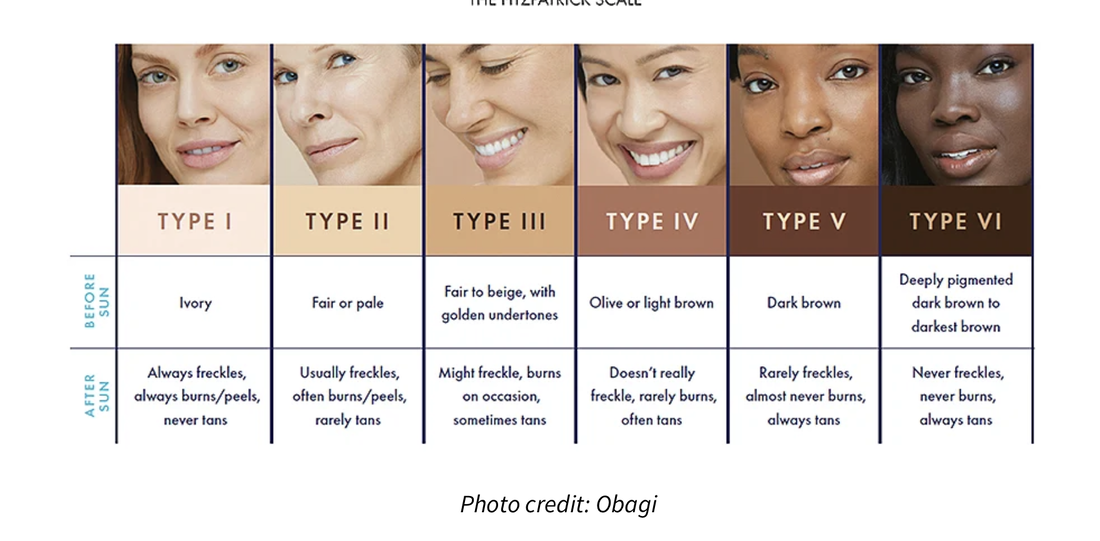While skincare commonly categorizes skin as oily, normal, or combination based on oil production and distribution, the crucial determinant of your skin's needs is its color-based type. The Fitzpatrick system, widely accepted, classifies skin into five types labeled I, II, III, IV, V, and VI. Discover your Fitzpatrick skin type using the image below to better understand and address your unique skincare requirements.
- Sensitive to sun exposure and wrinkle easily.
- Excellent sun protection is crucial.
- Anti-wrinkle ingredients like hyaluronic acid, glycerin, niacinamide, retinol (or bakuchiol).
- Gentle chemical exfoliants to encourage cell turnover.
- Free radical mitigation through antioxidant-rich serums with vitamin C, vitamin E, ferric acid, ellagic acid, and white willow bark.
- Prone to hyperpigmentation and scarring.
- Prioritize sun protection.
- Include skin-lightening ingredients such as vitamin C, saffron, ellagic acid, licorice, lotus flower, and lodhra to prevent hyperpigmentation.
- Use chemical exfoliants like lactic acid, salicylic acid, gluconolactone, azelaic acid to even out skin pigmentation.
- Incorporate niacinamide for brightening and even skin pigmentation.
- Use facial/body oils with botanicals like manjishta, alma, licorice, and saffron.
- Skin types I to III need extensive hydration, elasticity supporting strategies, and sun protection.
- Skin types IV to VI need hydration, pigmentation evening, skin brightening, and antioxidant rich products.
- Curate your Saroya Natural routine using the products below. If you live in a tropical climate, just eliminate the cream and add the powder cleanser.
- General recommendations for Vata types: following a Vata pacifying diet and incorporate stress reduction strategies such as meditation.
VATA TYPE I-III
Vata Type I-III Bundle
Elevate your hydration and sun protection game with our Timeless Radiance botanical facial oil, offering over ten Ayurvedic skin superstars for essential hydration and nourishment. Our superstar Vitamin C serum provides reliable UV protection, and the Vitamin Magic cream, enriched with aloe vera and vitamins A, B3, and E, ensures intense hydration for radiant skin. Boost your routine with our Instaglow face mask, used once every two weeks, for rejuvenated and revitalized skin.
VATA TYPE IV-VI
Vata Type IV-VI Bundle
Elevate your hydration and sun protection game with our Timeless Radiance botanical facial oil, featuring over ten Ayurvedic skin superstars for essential hydration and nourishment. Our superstar Vitamin C serum provides reliable UV protection, while the Vitamin Magic cream, enriched with aloe vera and vitamins A, B3, and E, ensures intense hydration for radiant skin. For pigmented skin, our Blemish Control Botanical Serum keeps blackheads at bay, ensuring an even complexion tone. Boost your routine with our Instaglow face mask, used once every two weeks, for rejuvenated and revitalized skin.
- Skin types I to III: Focus on caring for freckles that aggravated by sun exposure. Prioritize a good sunscreen and a vitamin C serum for essential protection.
- Skin types IV to VI: pay special attention to managing inflammatory acne and preventing scarring.
- General recommendations for all Pitta types: adopt an active acne management strategy with proper diet and acne busting skincare. Use a calming and cooling facial oil to balance sebum production.
- Curate your Saroya Natural routine using the products below. If you live in a tropical climate, just eliminate the cream and add the powder cleanser.
- You may add the Instaglow face mask as an optional treatment.
PItta type I-III
Pitta Type I-III Bundle
Experience the simplicity and gentle care your sensitive skin deserves. Our Vitamin C serum provides effective sun protection, while the calendula-infused facial oil soothes. Manage breakouts with our potent botanical serum. For added hydration, use our soothing cream with aloe vera. Boost your routine with our Instaglow face mask every two weeks for rejuvenated skin.
pitta type iv-vi
Pitta Type IV-VI Bundle
Nurture your sensitive, acne-prone skin with our powerful botanical serum, specially designed to keep blemishes at bay. Pair it with our superstar Vitamin C serum for effective UV protection, ensuring your skin is protected when you go out. Revitalize your skin with our Instaglow face mask for a dose of rejuvenating botanicals. Seal in moisture as needed with our calendula infused facail oil.
- The hallmark of Kapha is excessive oiliness. Oils and creams are generally unnecessary and may actively need to be avoided for all Kapha skin types.
- Kapha skin typically suffers from cystic acne. If you suffer from this, you will need to adopt cystic acne fighting strategies using diet and lifestyle in addition to skincare.
- Diet plays a huge role in controlling oil production. Avoid dairy, sugar, and oily foods.
- Curate your Saroya Natural routine using the products below.
kapha type i-iii
Kapha Type I-III Bundle
Embrace your natural glow while keeping oil under control. Use our gentle, soap-free cleanser to remove excess oil without over-drying. Our powerful botanical serum helps prevent breakouts, ensuring your skin stays clear. Maintain your radiant balance with a weekly treatment of our Instaglow face mask.
kapha type iv-vi
Kapha Type IV-VI Bundle
Embrace your natural glow while maintaining oil control with our gentle, soap-free cleanser. Our powerful botanical serum keeps breakouts at bay, ensuring clear skin. Even out blemishes and promote a bright complexion with our superstar Vitamin C serum. Maintain your radiant balance with a weekly treatment of our Instaglow face mask.

